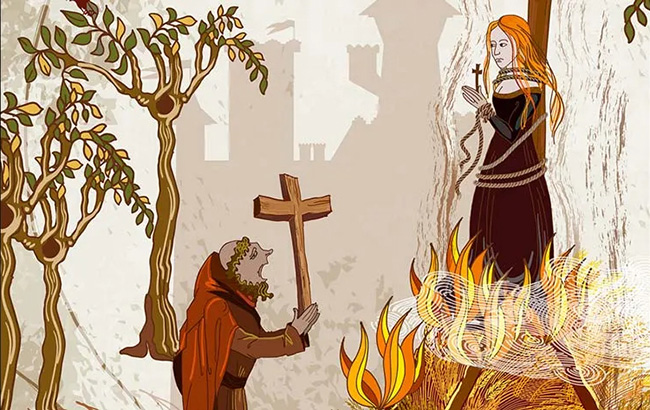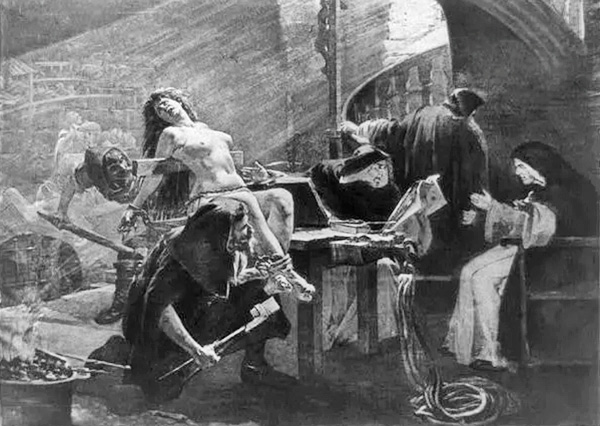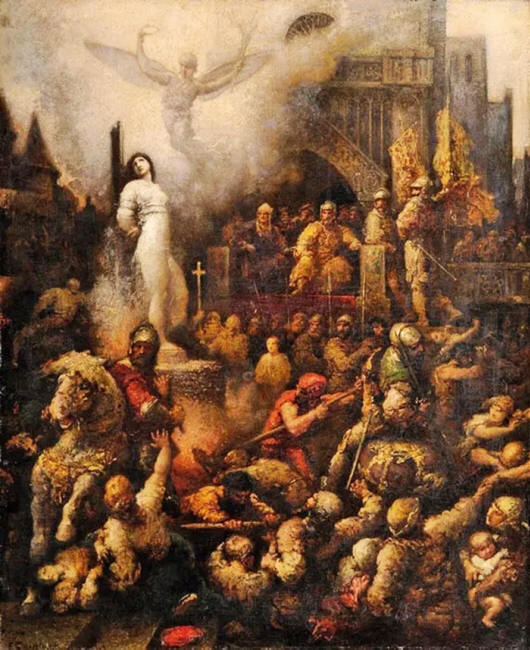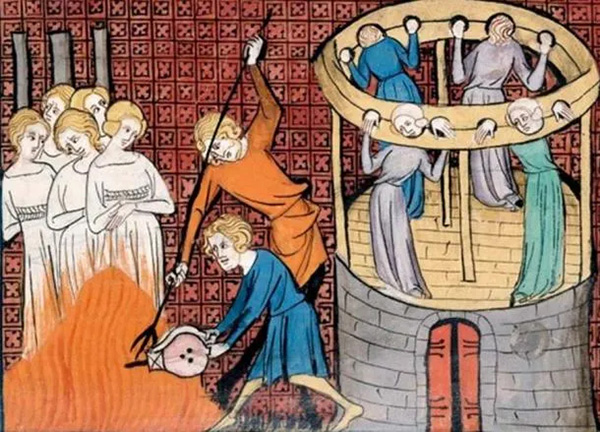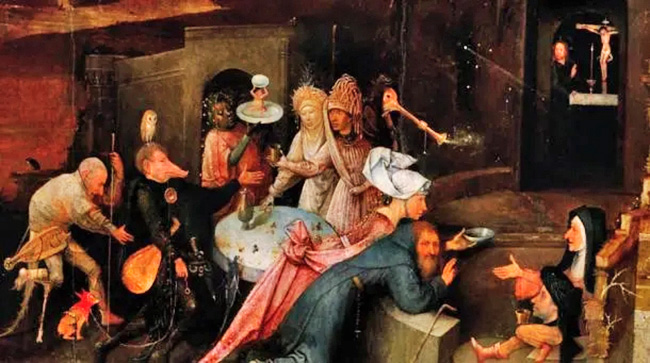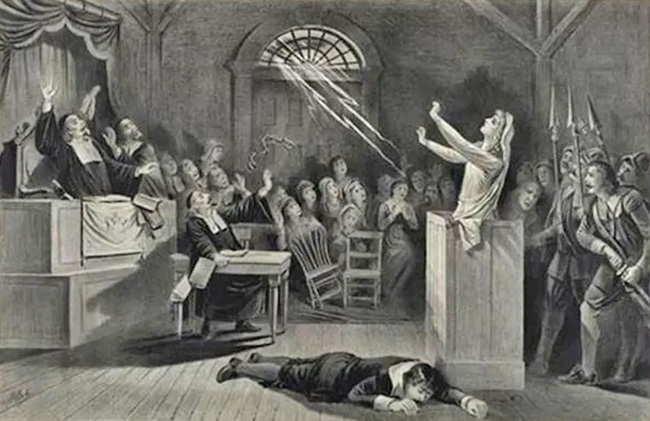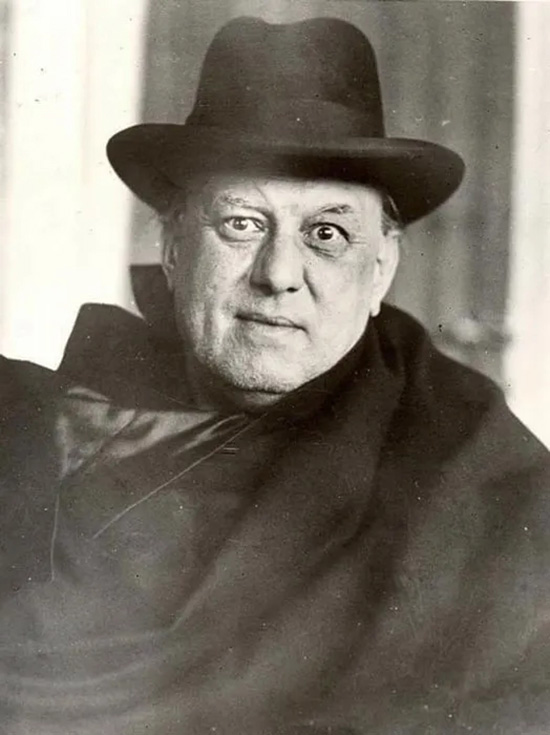|
by Phoenix Vald September 16, 2022
from
AncientOriginsUnleashed Website
The persecution of witches is a common theme within the history of witchcraft. Source: Matrioshka / Adobe Stock
By proposing a monotheist religious system, Christianity intended to change from the ground up this old state of affairs which had endured for centuries. However, the old traditions had deep roots in people's hearts and minds, a fact which made the Church feel threatened.
This clash between old traditions and the Christian cult resulted a long history of the persecution of witches.
Even though the conversion to Christianity had increased on the European continent, there were still those who believed, respected, and continued to take into account the old ways.
These talked about,
Even the nobles of the 12th and 13th centuries continued to respect the old traditions, troubadours composing songs in the honor of the Mother Goddess masked in the form of poems for courtesans.
In those turbulent times,
peasants and simple folk practiced witchcraft in the hope of
ensuring a better future for themselves, thinking that it could help
them to improve daily life. As Christianity extended its power and influence, clerics wanted to take measures against the old ways, and so the Church began the merciless war against that which it named the Devil's cult.
The measures imposed by
the representatives of the so-called "religion of mercy"
(Christianity) led to the violent death of over 200,000 people.
The fanaticism of the Church reached its peak in the period of the 12th and 18th centuries, then also being exported to the American territory.
by Spanish Inquisition, a common occurrence within the history of witchcraft.
(Public
domain)
Persecution in the
History of Witchcraft
The Church then regarded
as a threat the influence of Muslim traditions and ideas. As
European Modernism was also making its presence felt, the Church no
longer waited to see how these threats progressed, and it instituted
the Inquisition.
Among the first witch trials , which took place in the year 1324, Alice Kyteler from Kilkenny in Ireland was accused of worshipping the old gods and condemned to death.
As luck would have it she
enjoyed a noble position and managed to escape her fate, but her
acquaintances were executed and burnt at the stake.
Until then, the Great Plague from Europe, nicknamed the "Black Death", had resulted in the death of over 25 million people and the Hundred Years War had ended.
The most well-known episode within this second wave of persecutions is, without doubt, the execution of Joan of Arc.
The execution of Joan of Arc by Franšois Chifflart. (Public domain)
Later on, the same
institution which had executed her chose to sanctify her. In
addition to the motives of a political order which was responsible
for her execution, Joan of Arc has also been associated with a cult
dedicated to the goddess Diana...
Details from
the trial include reports that the young woman refused to say the
prayer "Our Father" during the trial, and that she spoke of "My
Lord" rather that "God".
The accusations claimed
that he had killed children from the neighboring villages. Gilles de
Rais has gone down in history as an alchemist and member of the
secret societies of the time.
As a condemnable act, all those who are suspected were to be investigated, by specially prepared inquisitors.
and holding others in the stocks. (Public domain)
In this way, in 1486, the
two published the work known under the title
Malleus Maleficarum (which translates to "The
Witches' Hammer") which set rules for the interpretation of
witchcraft activity.
The text passed, at that
time, through 35 editions, with versions in English, German, French
and Italian.
The first masonic lodges had appeared as a result of the works of the Order of the Templars which had been persecuted by the Church.
Martin Luther was excommunicated in the year 1521 after attacking the Vatican. Protestantism had begun to have influence, and in the year 1536, John Calvin set the bases of Calvinism.
In this period, Pope Paul
III, introduced the Inquisition in Rome and the peak of the third
wave of persecutions against witches, but also against Protestants,
began.
The convicted were
stripped naked in public, their bodies were shaved against a
backdrop of laughter as the crowd gathered in the public square.
These included physical
humiliations with sexual connotations, whipping, ripping off their
nails or being submerged underwater.
The "luckiest" convicts
were burned at the stake in an unconscious state induced by the
uninterrupted period of torture to which they had been submitted.
Another witch hunter named Peter Binsfeld, is said to have executed around 6,500 women and children under the accusation of witchcraft.
In the year 1834, the Inquisition was disbanded, but burning at the stake continued in Europe until the year 1793, the last witches being condemned and executed in Poland.
Satanic witchcraft included the practice of black mass. (Public domain)
One had its origins in a German community in Pennsylvania, where a brotherhood from Philadelphia used witchcraft to communicate with nature. In particular, from 1670 to 1700 they conducted ceremonies to celebrate the summer solstice, giving offerings to fertility gods.
They later incorporated additional elements into their belief systems, which resulted in a religion which centered on the worship of divine power in the guise of the Mother Goddess.
Their practices included,
The second form of magic practices which took place in North America did not constitute such a well-structured system, focusing more on the the practical side of things.
In this sense, witchdoctors performed healing rituals and spells with diverse purposes, varying from love or luck, or even detecting precious metals.
Among these witchdoctors,
known for practicing a type of magic inspired by
shamanic rituals
and the beliefs of
Native Americans, there were also some
preoccupied with black magic to whom one could make appeal to send
curses, disease or even death upon one's enemies.
These witches sneaked around at night, visiting churches where they held black masses.
These profanations of the
churches took place quite often in the 18th century as a result of
the black masses organized by witches who reversed Christian rituals
and their symbols, in order to provoke destruction.
It was said that a way of
recognizing this type of witch was through the presence of a
witches' mark, which supposedly appeared on the body as a result of
the pact made with the Devil.
Inquisitors believed that if these marks did not bleed when pierced
with a needle, then they were in fact witches' marks.
Lithograph depicting the Salem Witch trials.
(Public domain)
The Famed Salem Witch
Trials
Betty, the nine-year-old
daughter of priest Samuel Parris, and Abigail Williams,
her cousin, had been taught by the family's Indian slave named
Tituba about magical beliefs transmitted from the ancestors.
Over time she taught witchcraft practices to several young girls from Salem. Betty and Abigail began to enter trances, having seizures and running around the courtyard howling like wolves.
Other girls who had
entered into contact with Tituba began to act as if they were
absent, and when they came to they would say that they had seen
apparitions.
This is how the
investigations began to study the strange happenings from Salem and,
at the village tribunal, Betty Parris accused Tituba of practicing
witchcraft.
They also pointed the finger at a Sarah Osborne, an unmarried woman who lived with a man from the village, a scandalous thing at that time.
There was also Sarah
Good, an alcoholic beggar known for smoking a pipe, an eccentric
passion for her time.
Meanwhile, Sarah Osborne,
Sarah Good and another 17 women were condemned and executed for
practicing witchcraft.
In this way, someone could very easily get rid of a person whom he or she disliked.
All they had to do was to declare that they had been attacked by the spectral double of the individual and that individual would be executed for practicing witchcraft.
There was no escaping such an accusation since it was believed that a spectral double could act while the material body led its daily activity elsewhere.
Aleister Crowley was an English occultist and magician, who has been remembered for his sexual magic.
(Public domain)
The History of
Witchcraft in the 20th Century
On the contrary, it has
evolved and diversified, with a range of practices ranging from
white to black magic. In fact, the most well-known representatives
of black magic from history include
Aleister Crowley and
Anton Szandor LaVey.
After his failed attempt to control the society for his own interests, he was excluded from it. He has gone down in history as "The Worst Man from History", or "The Great Beast" as he liked to be called.
His reputation as a
magician was centered around sexual magic.
He also organized public ceremonies he considered to be a symbolical repetition of the seven rituals from Eleusis and for which those who wanted to participate had to pay enormous sums of money.
Another adept of black
and sexual magic, Anton Szandor LaVey, founded the Universal Church
of Satan in which he promoted the idea that unleashing sexual energy
can result in a special occult energy charge.
Based upon the old Celtic traditions of the druids,
This perspective rejects
the idea of the original sin, since white magic holds that humans
are sacred beings who contain divinity within themselves...
References
|


